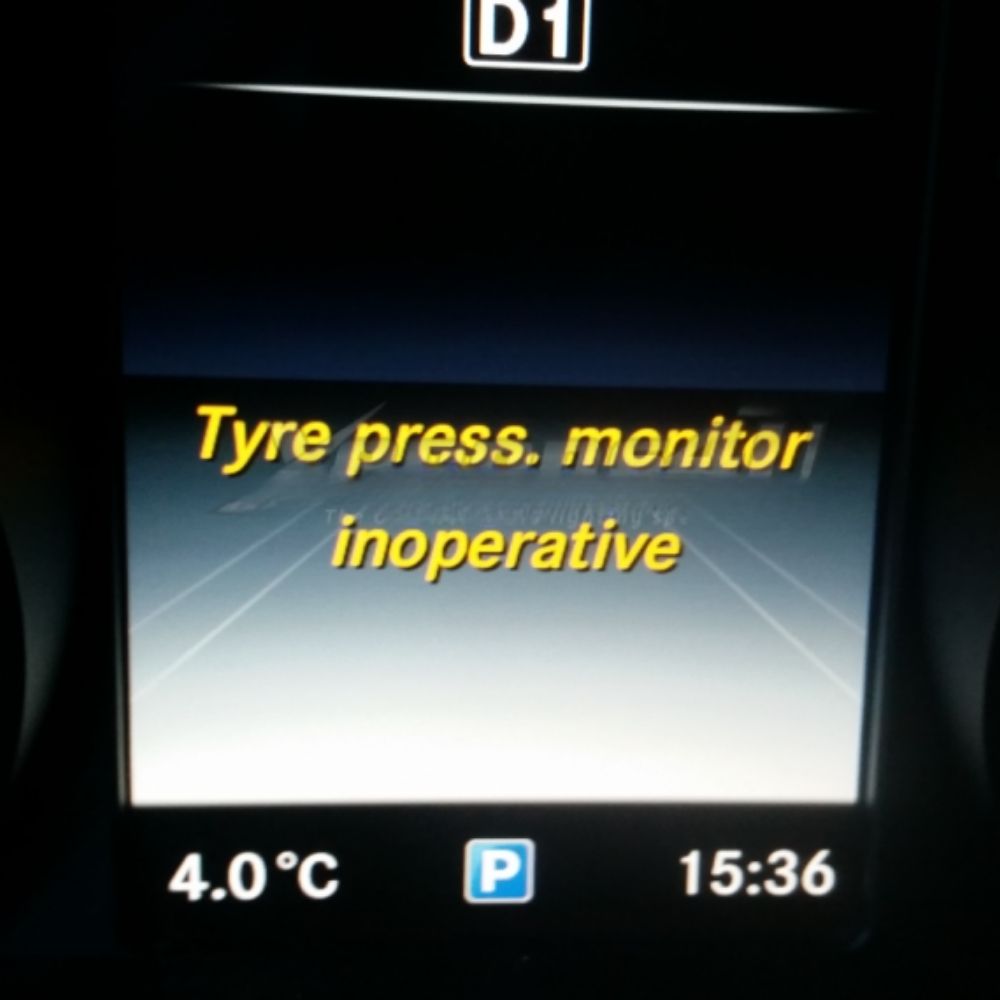
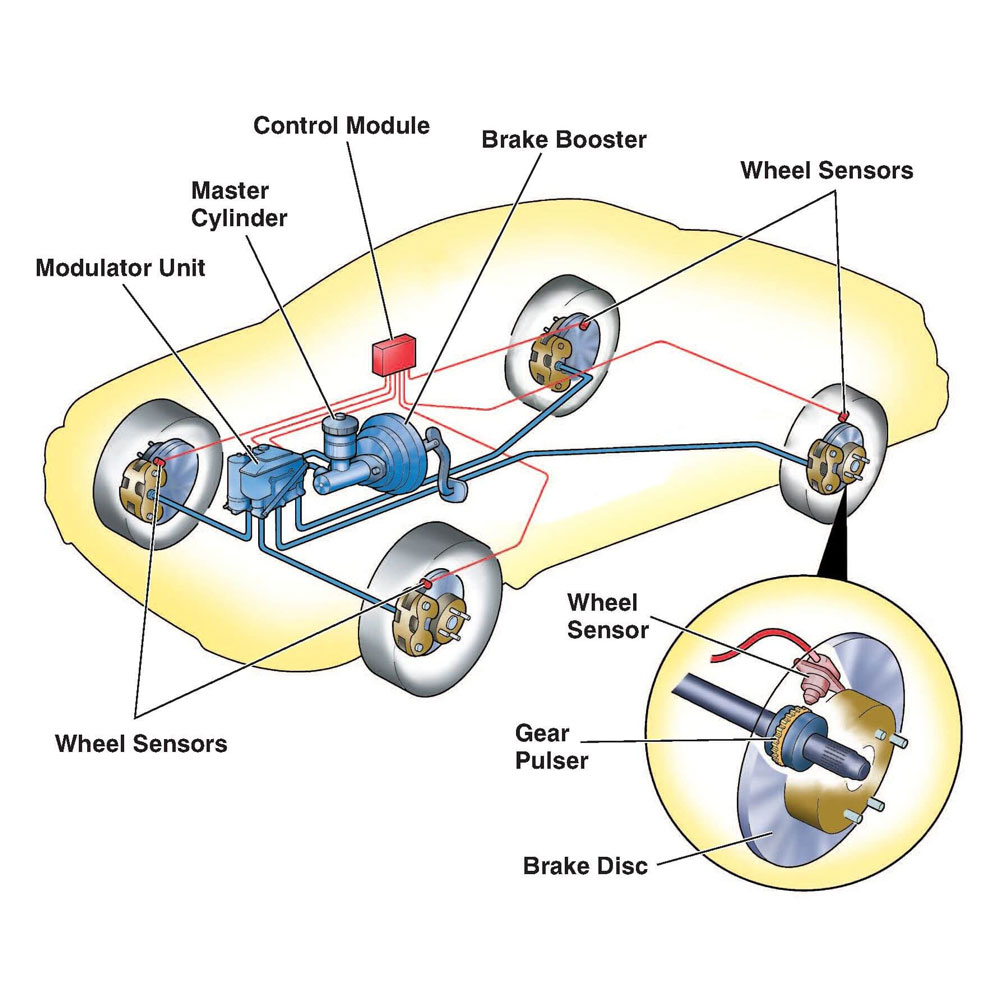
Anti-Lock Braking System (ABS) in Cars: What It Is and How It Works
Contents
- 1. What Is an Anti-Lock Braking System?
- 1.1. Anti Lock Braking System Definition
- 1.2. Why Cars Need Anti-Lock Braking Systems
- 1.3. How ABS Works in Real-World Driving Conditions
- 4.4. Statistics That Prove ABS in Cars Saves Lives
- 2. What Does the Anti Lock Braking System Do?
- 3. Main Components of the ABS Anti-Lock Braking System
- 3.1. Wheel Speed Sensors (WSS)
- 3.2. ABS Control Module (Electronic Control Unit – ECU)
- 3.3. Hydraulic Control Unit (HCU)
- 3.4. ABS Pump (Return Pump)
- 3.5. ABS Fuse and Relay
- 3.6. Brake Fluid Reservoir and Master Cylinder
- 3.7. Tone Rings / Reluctor Rings
- 4. How Does an Anti Lock Braking System Work?
- 4.1. What Happens During Sudden Braking Without ABS?
- 4.2. Step-by-Step Operation of the Anti Lock Braking System
- 4.3. A Real-Life Example: How ABS Prevents Lock-Up
- 5. Types of Anti Lock Braking System
- 5.1. Four-Channel, Four-Sensor ABS (4×4 ABS)
- 5.2. Three-Channel, Three-Sensor ABS
- 5.3. Two-Channel, Four-Sensor ABS
- 5.4. One-Channel, One-Sensor ABS (Single Channel ABS)
- 5.5. Off-Road ABS / Off-Road Mode
- 5.6. Integrated ABS with ESC (Electronic Stability Control)
- 5.7. Regenerative ABS (in Hybrid & Electric Vehicles)
- 6. Anti Lock Braking System in Car Applications
- 7. What if Anti Lock Braking System Has Problems
- 7.1. Common Symptoms of ABS Problems
- 7.2. Common ABS Issues Include:
- 8. Anti Lock Braking System Replacement & Repair
- 8.1. Common Repairs:
- 8.2. Average Cost:
- ✅ Need Help with ABS Issues? AutoExplain is Here for You!
- 🔧 Here’s What You Can Expect from AutoExplain:
- 💬 Get in Touch Today
- Conclusion
- ABS Module FAQs
The anti-lock braking system (ABS) is one of the most crucial safety technologies in modern vehicles. Whether you’re driving a car or riding a motorcycle, understanding the anti lock braking system can help you appreciate how it contributes to vehicle stability, driver control, and most importantly—accident prevention.
In this comprehensive guide, we’ll break down everything you need to know about ABS, including what it is, how it works, its components, types, common problems, and how it significantly improves vehicle safety during emergency braking.
1. What Is an Anti-Lock Braking System?
The anti-lock braking system (often referred to as the ABS anti-lock braking system) is a safety feature designed to prevent the wheels of a vehicle from locking up during hard braking. By keeping the tires rotating instead of skidding, the system helps maintain steering control and vehicle stability on slippery or sudden-stop conditions.
1.1. Anti Lock Braking System Definition
According to the SAE and most automotive manuals, the anti lock braking system definition is:
“A computer-controlled system that prevents the wheels from locking up during braking by rapidly modulating brake pressure.”
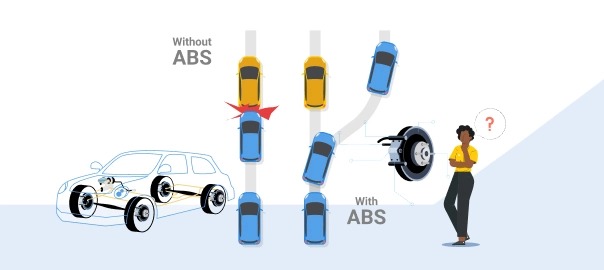
1.2. Why Cars Need Anti-Lock Braking Systems
Under hard or panic braking—especially on wet, icy, or loose surfaces—conventional brakes can cause the wheels to lock up. When a wheel locks up, it stops rotating but continues to slide over the surface, significantly reducing traction and eliminating steering control.
The ABS anti-lock braking system detects this situation and modulates brake pressure automatically. Instead of locking, the system pulses the brake pressure several times per second, allowing the wheel to slow down without skidding.
📌 This ensures that:
-
Steering remains possible, allowing the driver to avoid obstacles.
-
Stopping distance is optimized, especially on slippery surfaces.
-
Vehicle stability is maintained, even under full braking force.
1.3. How ABS Works in Real-World Driving Conditions
In car applications, ABS works seamlessly in the background and only activates when it detects imminent wheel lockup. Here’s how it performs in common road scenarios:
1. Wet or Icy Roads
🌧️ On rain-soaked or frozen roads, friction between tires and surface decreases significantly. ABS becomes critical by:
-
Detecting wheel deceleration faster than normal.
-
Pulsing the brake pressure to avoid wheel lock.
-
Helping drivers steer around hazards even while braking.
🛞 Without ABS: The wheels may lock, causing the car to skid uncontrollably.
2. Emergency Braking at High Speeds
🚨 During high-speed driving on highways, sudden obstacles (like an animal, another car, or debris) may force the driver to slam on the brakes.
-
ABS engages instantly, maintaining vehicle control.
-
Prevents rear-end collisions or crashes due to vehicle spin or oversteering.
✍️ ABS in high-speed braking is especially critical for large vehicles like SUVs and vans, which have a higher center of gravity and can easily lose control without ABS.
3. Gravel or Uneven Terrain
🏞️ On gravel roads or uneven terrain, conventional braking systems often lock the wheels due to inconsistent surface traction.
-
ABS helps retain traction on uneven or loose surfaces.
-
Some advanced cars even have Off-Road ABS modes that allow controlled wheel slip for better braking.
4. City Driving with Stop-and-Go Traffic
🚦 Even in urban environments, ABS proves useful:
-
In low-speed collisions, ABS prevents sudden wheel lock when braking to avoid a pedestrian or another vehicle.
-
Especially helpful for novice drivers or during moments of distraction.
4.4. Statistics That Prove ABS in Cars Saves Lives
Research and crash analysis from various global safety organizations show that cars equipped with ABS demonstrate:
-
35% fewer multi-vehicle crashes on wet roads.
-
20% reduction in overall crash risk.
-
Up to 30% shorter braking distances on slippery surfaces.
📌 According to NHTSA (National Highway Traffic Safety Administration):
“ABS reduces the risk of fatal crashes by approximately 24% in passenger cars and 30% in light trucks.”
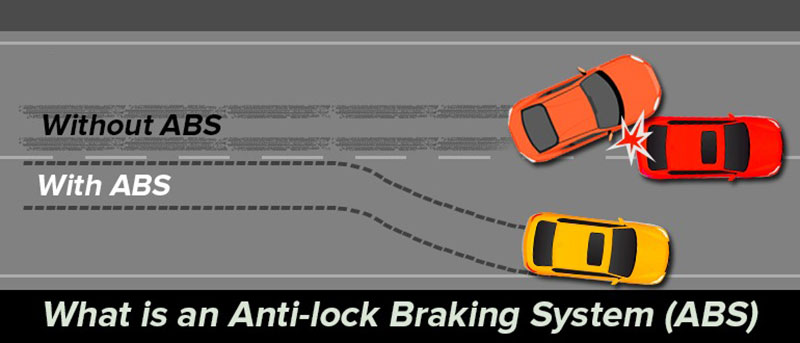
2. What Does the Anti Lock Braking System Do?
The ABS monitors wheel speed in real-time. When it detects a potential lock-up, it momentarily reduces brake pressure on the affected wheel, allowing it to rotate again. This process can happen up to 15 times per second, which is far faster than a human driver can react.
In short:
-
It prevents skidding
-
Maintains steering control
-
Reduces stopping distances under certain conditions
-
Enhances driver confidence in emergency situations
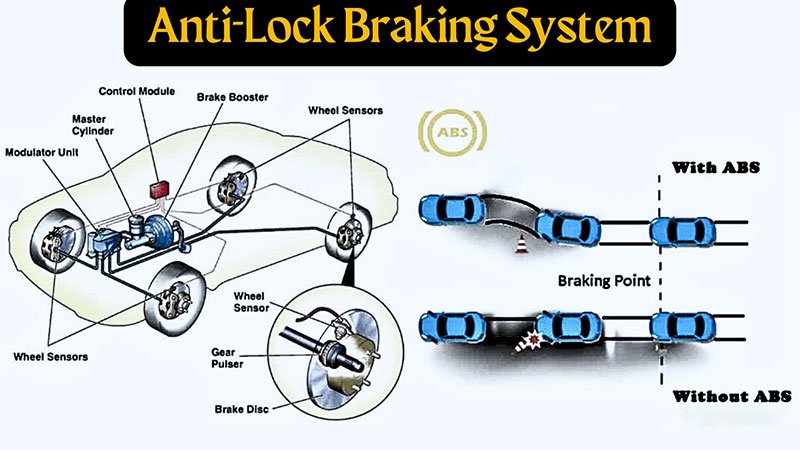
3. Main Components of the ABS Anti-Lock Braking System
The Anti-Lock Braking System (ABS) is a complex integration of electronic and hydraulic components, working in harmony to ensure optimal braking performance. Below is an in-depth look at the key components that make the ABS work efficiently:
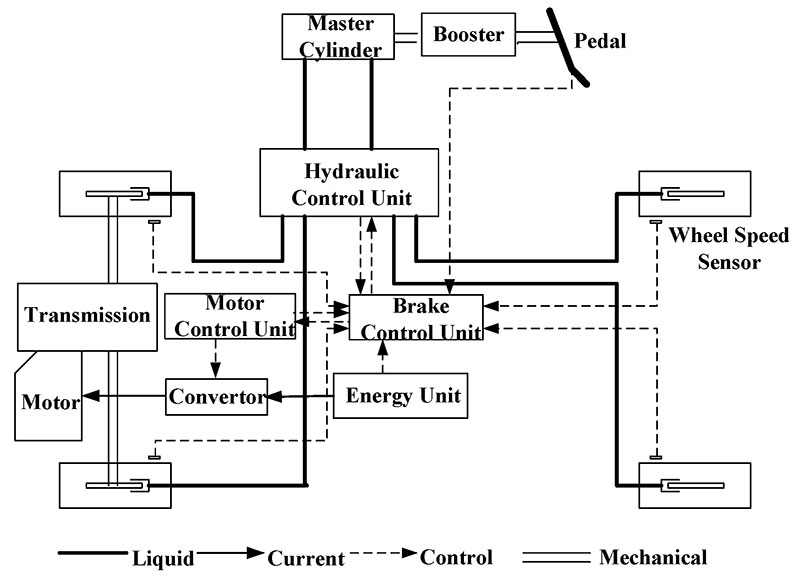
3.1. Wheel Speed Sensors (WSS)
🔍 Function:
Wheel Speed Sensors monitor the rotational speed of each wheel in real time. These sensors provide the ABS control module with critical data to detect when a wheel is about to lock up under braking.
⚙️ Types of Wheel Speed Sensors:
-
Passive sensors: Use magnetic induction and a toothed tone ring. They generate a variable AC voltage signal as the teeth move past the sensor.
-
Active sensors: Rely on Hall-effect or magnetoresistive technology and require power supply. They offer greater precision, especially at low speeds.
3.2. ABS Control Module (Electronic Control Unit – ECU)
🔍 Function:
The ABS control module acts as the brain of the system. It constantly monitors data from all wheel speed sensors and executes real-time decisions to prevent lock-up. When it detects a wheel decelerating too rapidly, it triggers the hydraulic modulator to adjust brake pressure.
💡 Key tasks:
-
Receive input from sensors
-
Run diagnostic checks on the ABS system
-
Control the timing and duration of pressure modulation via solenoid valves
-
Store fault codes when issues are detected
3.3. Hydraulic Control Unit (HCU)
This unit contains solenoid-operated valves and works directly under the direction of the ABS module to regulate brake fluid pressure to each wheel.
🔍 Function:
During ABS activation, the HCU adjusts hydraulic pressure sent to each brake caliper through three primary operations:
-
Pressure hold – Freezes brake pressure momentarily to stabilize wheel speed
-
Pressure reduction – Releases fluid to lower pressure on a locking wheel
-
Pressure increase – Restores pressure once the wheel regains traction
⚙️ Components inside HCU:
-
Inlet valves: Close to prevent additional pressure from entering the brake line
-
Outlet valves: Open to allow brake fluid to escape into the accumulator
-
Accumulator: Stores excess fluid temporarily during pressure release
-
Solenoids: Electromagnetic devices that actuate the valves
3.4. ABS Pump (Return Pump)
🔍 Function:
The ABS pump restores hydraulic pressure lost during the modulated braking cycle. When the outlet valve opens to release brake fluid from a caliper, the fluid is not wasted—it’s captured and then pushed back into the master cylinder lines by the pump to maintain effective braking.
⚠️ Importance note:
Without this pump, the brake pedal would become soft or sink during extended ABS operation. It ensures consistent pedal feel and maintains braking force throughout a panic stop.
3.5. ABS Fuse and Relay
The ABS fuse protects the electrical circuit from overcurrent, while the relay controls power delivery to the ABS pump and control unit.
3.6. Brake Fluid Reservoir and Master Cylinder
While technically part of the conventional braking system, the master cylinder plays a role in the overall ABS operation.
The master cylinder provides hydraulic pressure when the driver presses the brake pedal. The ABS modulates this pressure using the valves and pump. The fluid in the reservoir must remain at optimal levels to ensure proper ABS performance.
3.7. Tone Rings / Reluctor Rings
These are metallic rings with evenly spaced teeth mounted on the wheel hub, axle, or CV joint. They interact with the wheel speed sensors to generate data.
⚙️ Function:
As the wheel turns, the teeth of the tone ring pass by the sensor, which reads the frequency to calculate wheel speed.
4. How Does an Anti Lock Braking System Work?
The Anti-Lock Braking System (ABS) is a critical safety technology designed to prevent your vehicle’s wheels from locking up during hard braking, especially on slippery or uneven surfaces. Instead of allowing the wheels to skid uncontrollably, the ABS maintains traction between the tires and the road. But how does an anti lock braking system work exactly?
Let’s break it down step by step.
4.1. What Happens During Sudden Braking Without ABS?
In a conventional (non-ABS) braking system, when you apply the brakes forcefully:
-
The wheels can lock up, especially on wet, icy, or gravel roads.
-
A locked wheel skids instead of rolling, significantly reducing traction.
-
The driver loses steering control, and the vehicle may slide sideways or spin out.
That’s where ABS anti lock braking system comes in.
4.2. Step-by-Step Operation of the Anti Lock Braking System
Step 1: Continuous Wheel Speed Monitoring
The system begins with wheel speed sensors installed on each wheel or axle. These sensors continuously monitor how fast each wheel is rotating and send this data to the ABS control module.
-
Main keyword integration: The anti lock braking system in car depends on accurate wheel speed data to detect potential wheel lock-up.
Step 2: Detecting Rapid Deceleration or Lock-Up
If one or more wheels start to decelerate more quickly than others (a sign of possible lock-up), the ABS control module identifies the abnormality within milliseconds.
-
This is typically during panic braking, wet conditions, or when the road surface suddenly changes (e.g., from pavement to gravel).
Step 3: ABS Modulation Begins
To prevent the wheel from locking, the ABS controller sends a command to the hydraulic modulator unit (also called the Hydraulic Control Unit or HCU), which then:
-
Closes the inlet valve, preventing more brake fluid from applying pressure to the locking wheel.
-
Opens the outlet valve, allowing some brake fluid to be released from the caliper, reducing pressure.
This process is commonly referred to as “pressure modulation.”
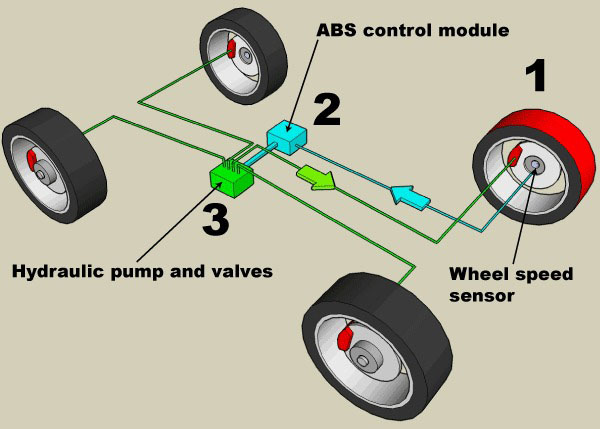
Step 4: Brake Pressure is Restored by the ABS Pump
After pressure is relieved, the ABS pump (or return pump) re-applies pressure by sending the brake fluid back to the caliper once the wheel resumes rotation.
-
This modulation cycle—reduce, hold, and increase pressure—can happen up to 15–20 times per second.
Step 5: Rapid Pulsing for Controlled Braking
You may feel the brake pedal pulsating under your foot during ABS operation. This is a normal effect of the system modulating pressure to avoid wheel lock-up. It allows the wheels to:
-
Continue rotating,
-
Maintain road contact,
-
Let the driver retain steering control.
This is what the anti lock braking system does: It helps you steer around obstacles while braking, rather than skidding into them.
4.3. A Real-Life Example: How ABS Prevents Lock-Up
Imagine you’re driving at 80 km/h on a wet highway. A deer jumps out in front of your car. You panic and slam on the brakes. Here’s what happens:
-
Without ABS: The front wheels lock, the car skids, you lose steering, and possibly crash.
-
With ABS: The system detects potential lock-up, modulates brake pressure, keeps the wheels rolling, and you maintain enough control to steer around the deer safely.
This is how anti lock braking system prevents the risk of sliding.
5. Types of Anti Lock Braking System
There are different types of anti-lock braking systems, based on the number of channels and sensors involved:
5.1. Four-Channel, Four-Sensor ABS (4×4 ABS)
Most advanced and common system in modern vehicles.
-
Each wheel has its own sensor and is monitored independently.
-
The system can modulate braking pressure to each wheel separately, providing maximum control and safety.
🔧 Used in:
-
Most modern passenger cars, SUVs, and luxury vehicles.
📌 Advantages:
-
Allows full control of all wheels.
-
Prevents wheel lock on any single wheel.
-
Enhances vehicle stability and steering control.
5.2. Three-Channel, Three-Sensor ABS
Common in older vehicles, especially those with rear drum brakes.
-
One sensor and modulator for each front wheel.
-
One sensor/modulator controls both rear wheels together.
🔧 Used in:
-
Older trucks, vans, and economy cars.
📌 Advantages:
-
Good front-wheel control.
-
Cheaper to implement than 4-channel ABS.
📌 Disadvantages:
-
Less effective at controlling rear wheel lockup.
-
Not ideal for uneven traction between rear wheels.
5.3. Two-Channel, Four-Sensor ABS
A mid-level system sometimes found in vehicles with split brake circuits.
-
Four wheel speed sensors.
-
Two hydraulic channels: usually one for front axle, one for rear axle.
🔧 Used in:
-
Mid-sized sedans, some SUVs.
📌 Advantages:
-
More refined than single-channel systems.
-
Decent compromise between performance and cost.
📌 Disadvantages:
-
Less precise than full four-channel control.
5.4. One-Channel, One-Sensor ABS (Single Channel ABS)
The simplest and least expensive ABS, mainly used in motorcycles and early pickup trucks.
-
A single wheel sensor (usually on the rear wheel).
-
One hydraulic modulator controls both rear brakes.
🔧 Used in:
-
Motorcycles, entry-level vehicles, or vehicles with rear drum brakes.
📌 Advantages:
-
Low cost, basic skid prevention.
-
Sufficient for lightweight vehicles.
📌 Disadvantages:
-
No front-wheel control.
-
Limited steering stability during emergency braking.
5.5. Off-Road ABS / Off-Road Mode
Some modern SUVs and trucks feature off-road ABS, a variant that modifies brake modulation frequency and pressure for:
-
Loose gravel, sand, mud, or snow.
📌 Features:
-
Allows slight wheel slip to dig into terrain for improved stopping power.
-
Enhances stability on rough or uneven surfaces.
🔧 Found in:
-
Jeep Wrangler, Land Rover, Toyota Land Cruiser, etc.
5.6. Integrated ABS with ESC (Electronic Stability Control)
In modern safety suites, ABS is integrated with:
-
Traction Control Systems (TCS)
-
Electronic Stability Control (ESC or VSC)
📌 These systems use the same ABS sensors and modulator but go further:
-
Detect vehicle yaw, pitch, or oversteer.
-
Apply brakes to individual wheels to correct loss of control.
This is part of how anti-lock braking system vehicle stability control functions.
5.7. Regenerative ABS (in Hybrid & Electric Vehicles)
✅ In electric vehicles (EVs) and hybrids, braking is shared between:
-
Friction brakes, and
-
Regenerative braking (which uses the electric motor to slow the vehicle and recharge the battery).
📌 The ABS must be intelligently integrated to handle:
-
Brake blending.
-
Smooth modulation between regen and hydraulic braking.
-
Reliable stopping even if regen is not available.
🔧 Used in:
-
Tesla, Toyota Prius, Hyundai Ioniq, etc.
6. Anti Lock Braking System in Car Applications
The anti lock braking system in car applications is deeply integrated with other safety systems, including:
-
Electronic Brakeforce Distribution (EBD)
-
Traction Control System (TCS)
-
Electronic Stability Control (ESC)
This integration helps cars:
-
Corner safely in emergencies
-
Recover from sudden loss of grip
-
Stay stable even during aggressive maneuvers
7. What if Anti Lock Braking System Has Problems
Like all automotive systems, ABS can fail or degrade over time. If an Anti-Lock Braking System (ABS) has problems, it can compromise your vehicle’s safety during emergency braking or on slippery roads.
-
Loss of Skid Protection
ABS prevents wheels from locking up during hard braking. Without it, your car is more likely to skid, especially on wet, icy, or loose surfaces. -
Increased Stopping Distance
On slippery roads, ABS helps reduce stopping distance. If ABS fails, you may need more room to stop safely. -
Steering Control Issues During Braking
ABS allows you to steer while braking hard. A malfunctioning ABS can make the vehicle harder to control in emergencies. -
Brake Lockup in Emergencies
Especially in panic braking, without ABS the wheels might lock up, causing the car to slide uncontrollably.
7.1. Common Symptoms of ABS Problems
-
ABS Warning Light
The ABS dashboard light stays on or flashes, indicating a system fault. -
Brakes Lock During Hard Stops
You feel or hear wheels skidding or locking up when braking suddenly. -
Unusual Brake Pedal Behavior
-
Pulsation or vibration during normal braking
-
Brake pedal feels unusually hard or soft
-
-
Loss of Traction During Braking
Vehicle tends to swerve or fishtail under heavy braking. -
Noise From ABS Module or Pump
Clicking, buzzing, or grinding noises during braking may indicate internal ABS issues.
7.2. Common ABS Issues Include:
1. Faulty Wheel Speed Sensors
-
What it does: Measures the speed of each wheel and sends data to the ABS control module.
-
Common issues:
-
Dirt, debris, or rust buildup
-
Sensor damage or misalignment
-
Corroded connectors
-
-
Symptoms:
-
ABS warning light
-
Inconsistent or no ABS engagement
-
2. Damaged or Dirty Tone Rings (Reluctor Rings)
-
What it does: Works with wheel speed sensors to provide wheel speed data.
-
Common issues:
-
Cracked or broken teeth
-
Rust or debris buildup
-
-
Symptoms:
-
Pulsating brake pedal
-
ABS light comes on intermittently
-
3. Bad ABS Module (ABS Control Unit)
-
What it does: The brain of the ABS system, processing sensor inputs and controlling braking force.
-
Common issues:
-
Internal electronic failure
-
Software glitches
-
Water damage
-
-
Symptoms:
-
Complete loss of ABS function
-
Dashboard ABS and brake warning lights
-
4. Hydraulic Pump or Valve Block Failure
-
What it does: Controls brake fluid pressure to prevent wheel lockup.
-
Common issues:
-
Valve block solenoid failure
-
Pump motor failure
-
Air in hydraulic lines
-
-
Symptoms:
-
Hard or soft brake pedal
-
Reduced braking efficiency
-
ABS warning light
-
5. Wiring or Electrical Issues
-
What it does: Connects all ABS components for communication and control.
-
Common issues:
-
Broken or frayed wires
-
Loose connectors
-
Blown fuses
-
-
Symptoms:
-
ABS light on intermittently
-
Sensor signal loss
-
Communication errors in scan tools
-
6. Low or Contaminated Brake Fluid
-
What it does: Essential for hydraulic braking and ABS pump operation.
-
Common issues:
-
Low fluid due to leaks
-
Moisture contamination
-
-
Symptoms:
-
Soft brake pedal
-
ABS or brake warning lights
-
Reduced braking performance
-
7. Blown ABS Fuse or Relay
-
What it does: Powers the ABS control module or pump.
-
Common issues:
-
Electrical short circuits
-
Overheating components
-
-
Symptoms:
-
ABS light on
-
No ABS pump operation
-
8. ABS Warning Light On (Without Clear Cause)
-
What it means: The system detected a fault — could be real or due to:
-
Intermittent sensor signals
-
Incorrect wheel size/tire pressure
-
Battery voltage drops or spikes
-
When experiencing anti lock braking system problems, the vehicle often stores fault codes that can be read using a diagnostic scanner.
8. Anti Lock Braking System Replacement & Repair
If the ABS malfunctions, it’s important to fix it promptly.
8.1. Common Repairs:
-
Replacing wheel speed sensors
-
Cleaning sensor rings
-
Repairing or replacing ABS wiring
-
Changing the ABS module or hydraulic unit
=> Contact AutoExplain via Whatsapp +1(936)2896695 to be provided ABS wiring diagram for free
8.2. Average Cost:
-
$100 – $400 for sensor replacement
-
$600 – $1500+ for ABS module replacement
Always ensure that ABS components are OEM-compliant and that bleeding procedures are followed properly post-repair.
✅ Need Help with ABS Issues? AutoExplain is Here for You!
If your dashboard is lit up with an ABS warning light, or you’re dealing with confusing brake fault codes like C249F, 5DF0, or 00283, don’t guess—get expert help.
At AutoExplain, we specialize in professional automotive diagnostics, ABS system troubleshooting, and remote coding/programming support for vehicles like Mercedes-Benz, BMW, and Audi.
🔧 Here’s What You Can Expect from AutoExplain:
-
✅ Accurate Diagnosis with OEM-grade software (Xentry, ISTA, VCDS)
-
✅ Live Remote Support for scanning ABS fault codes and guiding repairs
-
✅ Verified Repair Procedures tailored to your vehicle make and model
-
✅ ABS Sensor & Module Programming (where supported)
-
✅ Support for both cars and motorcycles with ABS systems
💬 Get in Touch Today
Stop struggling with warning lights or confusing error messages. Let our experienced technicians guide you—step-by-step—toward a safer and more reliable braking system.
📞 Contact via WhatsApp: +1(936)2896695
🌐 Or visit our website to book a diagnostic session now.
Conclusion
The anti-lock braking system is not just another automotive buzzword. It’s a life-saving technology that dramatically improves driving safety. Whether you’re a car owner, a technician, or a motorcycle enthusiast, understanding ABS helps you:
-
Drive smarter
-
Diagnose issues faster
-
Avoid accidents
The ABS (Anti-lock Braking System) module is a critical component in modern vehicles, ensuring optimal braking performance and safety. AutoExplain provides expert insights into the ABS module, including its function, common issues, and how to address them efficiently. Let’s explore everything you need to know about your car’s ABS module, including its role, symptoms of failure, and how to troubleshoot problems.
ABS Module FAQs
To help you further understand ABS modules, here are some frequently asked questions:
Q1: What is the primary function of the ABS module?
- A: The ABS module manages the anti-lock braking system, preventing wheel lockup during emergency stops.
Q2: How do I know if my ABS module is failing?
- A: Common symptoms include an illuminated ABS warning light, malfunctioning ABS, and unintended ABS activation.
Q3: Can I drive with a faulty ABS module?
- A: Driving with a defective ABS module can compromise vehicle safety, so it’s best to address the issue as soon as possible.
Q4: How do I test my ABS module?
- A: Testing involves retrieving diagnostic trouble codes, performing a visual inspection, and consulting service information for specific diagnostic procedures.
Q5: What causes ABS module failure?
- A: Common causes include moisture, corrosion, software glitches, and normal wear and tear.
Q6: Where is the ABS control module located?
- A: The ABS control module is typically mounted to the hydraulic control unit in the engine compartment.
Q7: What is ABS module coding?
- A: Coding involves configuring the ABS module’s software to match your vehicle’s specific requirements.
Q8: What is ABS module programming?
- A: Programming involves updating the ABS module’s software to the latest version.
Q9: Are OEM or aftermarket ABS modules better?
- A: OEM modules are guaranteed to fit and function correctly, while aftermarket modules can be more affordable but may vary in quality.
Q10: How can AutoExplain help with ABS module issues?
- A: AutoExplain offers comprehensive coding and programming services for ABS modules, ensuring optimal performance and safety.

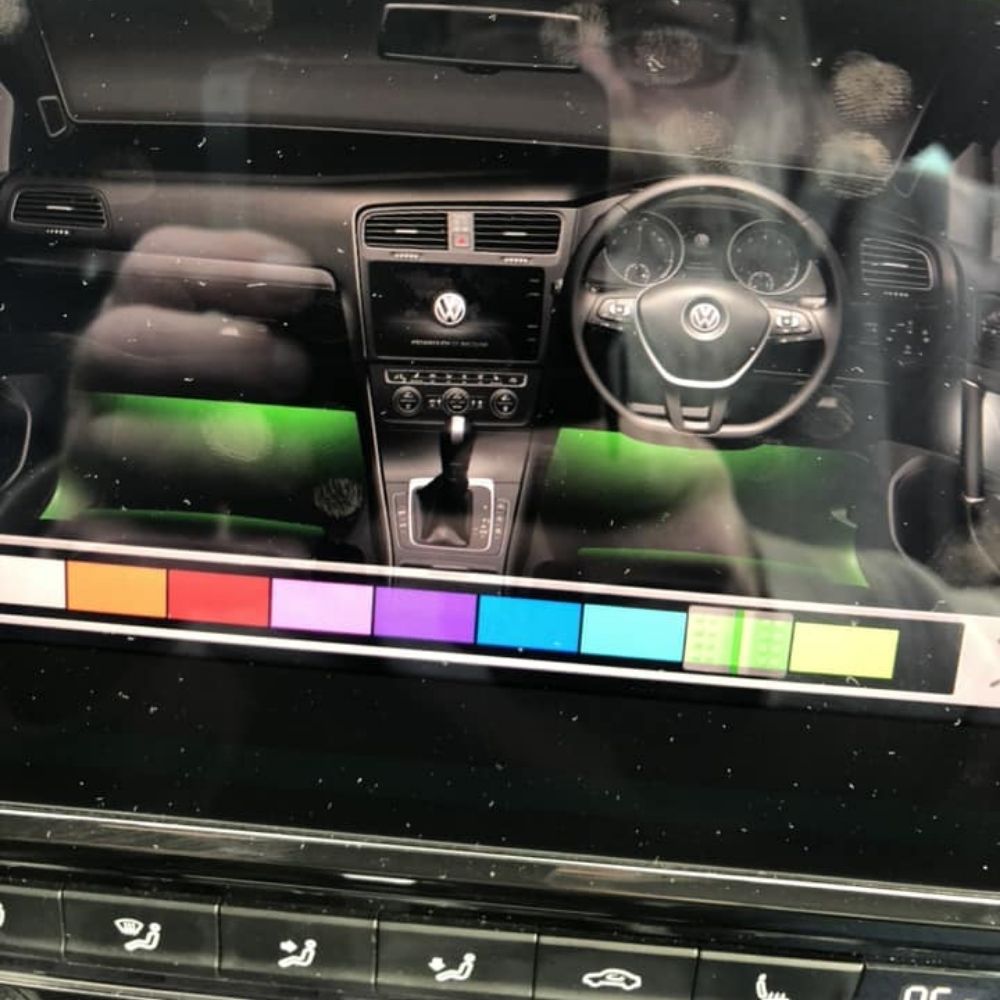
How to Coding Ambient Light for VW Golf R 2018 by OBDeleven

How to Perform 7 Speed DSG Basic Settings with ODIS on Skoda Octavia
